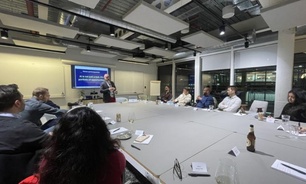Upskilling vs hiring: how your organization can keep up with AI
 by Callum Stainer
by Callum Stainer
Joining 22,000 data and AI experts at the Databricks Data and AI Summit last month, I spoke to many clients about the impact of AI on their business. Whether it’s automating simple processes to increase their efficiency, or analyzing mounds of data to enhance decision making, organizations are utilizing AI to complete a whole host of routine tasks and objectives.
But with AI’s capabilities apparently increasing by the day, keeping their skills up to date to utilize this technology is not all plain sailing. A recurring theme was that many organizations are struggling to come up with a solid business case or applications for AI. In addition, by the time they do decide on a business case, the technology has quite often already moved onto its next stage. There’s also a well-publicized digital skills gap as degree courses and training programs struggle to keep up with emerging technologies. So how can organizations acquire the AI skills they need in a changing environment?
The foundation to your knowledge: the value of upskilling
Rather than replacing their people, many of the businesses I spoke to are instead rolling out AI pilots and upskilling their workforce. As well as allowing them to utilize their people for more complex tasks, this gives the organization a foundational knowledge in AI based on the continuity of their current workforce, allowing them to build their capability in the future.
Upskilling your workforce in new technologies like generative AI needs to be in the form of a tailored development plan for each individual. This will ensure that what they learn and when they learn it is relevant to the business, thereby aligning their personal objectives with the business’s.
At a time when many employees are concerned about the longevity of their roles, training them in AI shows them that the business is committed to investing in them, not just for now but for their future career. When applying for new roles, professionals now often need to demonstrate familiarity with AI – so upskilling is crucial to remaining relevant, particularly if certain aspects of their role can now be automated.
It’s not easy, but it’s important to anticipate the skills your organization might need in the future. Some businesses are partnering with coding institutions in order to strengthen their future talent pipeline, even sponsoring individuals to work through degree courses and then join on an internship. It’s all part of ensuring a consistent supply of talent, with up-to-date AI skills, to futureproof your business.
Staying fresh: the importance of external talent
Your internal capability in AI may only reach a certain point, which means it’s risky being completely reliant on upskilling. While it’s easier and cheaper to retain the talent you have in tough financial times, the only way of keeping up with a steep learning curve is to supplement your existing skills with talent from outside the organization. These experts will bring new skills, perspectives and knowledge of new technologies that you don’t already have in your business. Plus, they can share their knowledge with your existing workforce, helping to elevate your overall level of expertise and embed a growth-first mindset.
Looking externally for skills means investing in your employer branding to stand out in a competitive recruitment market. Organizations need to show potential employees that they’ll get to work with the latest technologies and receive the training they need both to use these technologies effectively and to adapt to new ones.
When you need certain skills immediately, hiring these skills, rather than building them over time, is a lot more practical – but unless you have an unlimited recruitment budget, it’s also unsustainable. Redeployment can be a more cost-effective alternative to hiring. By conducting thorough assessments of current employees using performance reviews, skills evaluations and manager feedback, an organization can identify existing staff who could potentially elevate their AI capabilities. Another approach is to break roles down into granular tasks to pinpoint the specific skills required and identify people who can be redeployed from other areas of the business.
Conclusion: a balanced approach to AI skills
By adopting a balanced approach to talent, based on the continuity of their existing team augmented by the skills of new hires, organizations can ensure they have the foundational knowledge and the capacity to adapt to any upgrades in existing technologies and the introduction of new technologies.
But the worst thing you can possibly do is invest in the AI technology you need, ensure a few people in your business can use it, and then assume your work is done. Technology doesn’t stand still, and neither can you. Your talent needs to be allied to a mindset of continuous improvement, and that means committing to ongoing learning and flexibility to equip you for the future.
If you’re an organization looking for support in acquiring the AI skills your business needs, or you’re a professional looking for your next role in data or AI, contact me at callum.stainer@eamesconsulting.com or a member of the team.
Fresh Content
Explore our latest market insights, career advice, and more.











































